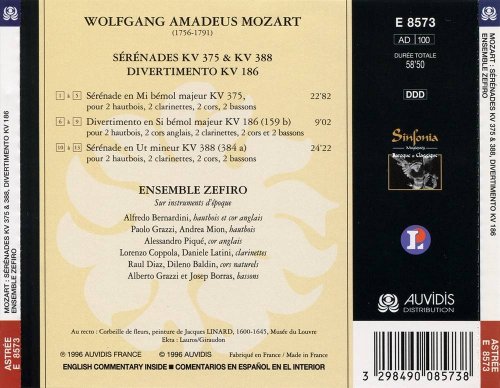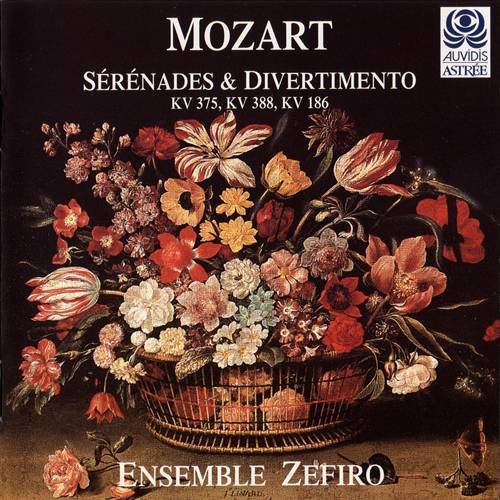
Ensemble Zefiro - Mozart: Sérénades & Divertimento (1996) CD-Rip
BAND/ARTIST: Ensemble Zefiro
- Title: Mozart: Sérénades & Divertimento
- Year Of Release: 1996
- Label: Auvidis ASTRÉE
- Genre: Classical
- Quality: FLAC (image+.cue,log,scans)
- Total Time: 58:50
- Total Size: 272 Mb
- WebSite: Album Preview
Tracklist:
Sérénade en Mi bémol majeur KV 375,
pour 2 hautbois, 2 clarinettes, 2 cors, 2 bassons
1. Allegro maestoso
2. Menuetto
3. Adagio
4. Menuetto
5. Finale
Divertimento en Si bémol majeur KV 186 (159 b)
pour 2 hautbois, 2 cors anglais, 2 clarinettes, 2 cors, 2 bassons
6. Allegro assai. Menuetto
7. Andante
8. Adagio
9. Allegro
Sérénade en Ut mineur KV 388 (384 a)
pour 2 hautbois, 2 clarinettes, 2 cors, 2 bassons
10. Allegro
11. Andante
12. Menuetto
13. Allegro
Performers:
ENSEMBLE ZEFIRO
Sur instruments d'époque
Sérénades KV 375 & KV 388
Paolo Grazzi, Alfredo Bernardini, hautbois
Lorenzo Coppola, Daniele Latini, clarinettes
Raul Diaz, Dileno Baldin, cors naturels
Alberto Grazzi et Josep Borras, bassons
Divertimento KV 186
Paolo Grazzi, Andrea Mion, hautbois
Alfredo Bernardini, Alessandro Piqué, cors anglais
Lorenzo Coppola, Daniele Latini, clarinettes
Raul Diaz, Dileno Baldin, cors naturels
Alberto Grazzi et Josep Borras, bassons
INSTRUMENTS
Hautbois de Bernardini & Ceccolini 1994 d'après Grundmann & Floth, Dresde ca. 1790 (2 clefs) / M. Ponseele 1993 d’apres H. Grenser
Cor anglais de Bernardini & Everts 1988 d’après Floth / O. Cottet 1986 d’après Floth
Clarinettes de Bangham 1992 d’après H. Grenser
Cors naturels de Paxman 1985 d’après Raoux, Paris ca. 1800 et de A. Jungwerth 1991 d’après Courtois, Paris ca. 1820
Bassons de H. Grenser ca. 1790 et de Rust, Lyon ca. 1790

Sérénade en Mi bémol majeur KV 375,
pour 2 hautbois, 2 clarinettes, 2 cors, 2 bassons
1. Allegro maestoso
2. Menuetto
3. Adagio
4. Menuetto
5. Finale
Divertimento en Si bémol majeur KV 186 (159 b)
pour 2 hautbois, 2 cors anglais, 2 clarinettes, 2 cors, 2 bassons
6. Allegro assai. Menuetto
7. Andante
8. Adagio
9. Allegro
Sérénade en Ut mineur KV 388 (384 a)
pour 2 hautbois, 2 clarinettes, 2 cors, 2 bassons
10. Allegro
11. Andante
12. Menuetto
13. Allegro
Performers:
ENSEMBLE ZEFIRO
Sur instruments d'époque
Sérénades KV 375 & KV 388
Paolo Grazzi, Alfredo Bernardini, hautbois
Lorenzo Coppola, Daniele Latini, clarinettes
Raul Diaz, Dileno Baldin, cors naturels
Alberto Grazzi et Josep Borras, bassons
Divertimento KV 186
Paolo Grazzi, Andrea Mion, hautbois
Alfredo Bernardini, Alessandro Piqué, cors anglais
Lorenzo Coppola, Daniele Latini, clarinettes
Raul Diaz, Dileno Baldin, cors naturels
Alberto Grazzi et Josep Borras, bassons
INSTRUMENTS
Hautbois de Bernardini & Ceccolini 1994 d'après Grundmann & Floth, Dresde ca. 1790 (2 clefs) / M. Ponseele 1993 d’apres H. Grenser
Cor anglais de Bernardini & Everts 1988 d’après Floth / O. Cottet 1986 d’après Floth
Clarinettes de Bangham 1992 d’après H. Grenser
Cors naturels de Paxman 1985 d’après Raoux, Paris ca. 1800 et de A. Jungwerth 1991 d’après Courtois, Paris ca. 1820
Bassons de H. Grenser ca. 1790 et de Rust, Lyon ca. 1790
Ensemble Zefiro, a period instrument group, give careful, attentive readings of Mozart’s two big octet serenades. In each case the opening movement is rather deliberate but very exactly judged in terms of dynamics and accentuation, and collectively very efficiently and precisely executed. The remaining movements are taken quite quickly, especially the minuets (the second of K375 seems unduly so and the trio is done much more slowly; while the canonic one in K388 is a little lightweight). The Andante of K388 loses something of its warmth and depth of expression, and is a shade bland: there is not much feeling of how the music wants to be shaped and, austerely, the group never dwell on cadences or make caesuras where the lines should breathe, either in this movement or in the Adagio of K375. Often I felt that they observed the letter of the score without really entering into the spirit. The players’ individual musicianship seems very constrained.
That is where the English Concert Winds do very much better on the Hyperion disc. The actual sound is less blended, you might say less impersonal, and this is not only a matter of the recording: here we have a team of individual musicians who play with a natural spontaneity and listen and react to one another. The sound is livelier and richer though less unified; the strands are clearly discernible even in tuttis. It has two exceptional musicians at the top of the texture: Colin Lawson, whose clarinet playing is both sparkling and sensitive, especially in K375 where the clarinet tends to predominate, and Paul Goodwin, with much exquisite oboe playing, in the slow movement of K388 and perhaps most of all in the finale where the oboe variation has delightful refinements of timing. There are some distinguished touches from Anthony Halstead’s horn too; the first bassoonist, Alberto Grazzi, plays in both recordings, with due virtuosity in the bassoon variation in the K388 finale. The English group excel not only individually but in their sense of the architecture of the music, their natural feeling for the broader spans and the moulding of the climaxes. One flaw: in bar 32 of the first movement of K388, both times, there is a wrong second clarinet G (sounding F), introducing an unMozartian French sixth and creating an impossible dissonance. I don’t think this can be one of the textual rectifications claimed in the note for the new edition, based on Mozart’s autographs, that is used here (which I do not imagine improves on the excellent Neue Mozart-Ausgabe text, also based on the autographs and used for several previous recordings).
The Zefiro recording offers one of the pair of divertimentos Mozart wrote in 1773 for wind octet plus two cors anglais; these are very slender and rather odd little pieces, possibly not wholly by Mozart. It receives a cool, brisk reading here. The English Concert Winds disc offers as fill-up contemporary wind arrangements of Mozart’s three most popular opera overtures – these are somewhat cut versions, effectively arranged and played sympathetically; they make entertaining listening, a reminder of what the late eighteenth- or early nineteenth-century listener could hear at a bandstand. This disc, full of imaginative and musicianly playing, can be firmly recommended.
That is where the English Concert Winds do very much better on the Hyperion disc. The actual sound is less blended, you might say less impersonal, and this is not only a matter of the recording: here we have a team of individual musicians who play with a natural spontaneity and listen and react to one another. The sound is livelier and richer though less unified; the strands are clearly discernible even in tuttis. It has two exceptional musicians at the top of the texture: Colin Lawson, whose clarinet playing is both sparkling and sensitive, especially in K375 where the clarinet tends to predominate, and Paul Goodwin, with much exquisite oboe playing, in the slow movement of K388 and perhaps most of all in the finale where the oboe variation has delightful refinements of timing. There are some distinguished touches from Anthony Halstead’s horn too; the first bassoonist, Alberto Grazzi, plays in both recordings, with due virtuosity in the bassoon variation in the K388 finale. The English group excel not only individually but in their sense of the architecture of the music, their natural feeling for the broader spans and the moulding of the climaxes. One flaw: in bar 32 of the first movement of K388, both times, there is a wrong second clarinet G (sounding F), introducing an unMozartian French sixth and creating an impossible dissonance. I don’t think this can be one of the textual rectifications claimed in the note for the new edition, based on Mozart’s autographs, that is used here (which I do not imagine improves on the excellent Neue Mozart-Ausgabe text, also based on the autographs and used for several previous recordings).
The Zefiro recording offers one of the pair of divertimentos Mozart wrote in 1773 for wind octet plus two cors anglais; these are very slender and rather odd little pieces, possibly not wholly by Mozart. It receives a cool, brisk reading here. The English Concert Winds disc offers as fill-up contemporary wind arrangements of Mozart’s three most popular opera overtures – these are somewhat cut versions, effectively arranged and played sympathetically; they make entertaining listening, a reminder of what the late eighteenth- or early nineteenth-century listener could hear at a bandstand. This disc, full of imaginative and musicianly playing, can be firmly recommended.

Classical | FLAC / APE | CD-Rip
As a ISRA.CLOUD's PREMIUM member you will have the following benefits:
- Unlimited high speed downloads
- Download directly without waiting time
- Unlimited parallel downloads
- Support for download accelerators
- No advertising
- Resume broken downloads


